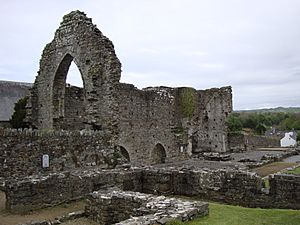St Dogmaels Abbey facts for kids
St Dogmael's Abbey is an old abbey located in St Dogmaels, Pembrokeshire, Wales. It sits by the River Teifi, near the towns of Cardigan and Poppit Sands. The abbey is named after Saint Dogmael, a holy person from the 6th century. People believe he was related to Saint David, the patron saint of Wales.
Contents
The Abbey's Beginning
The abbey was built on a very old church site called Llandudoch. It was started between 1113 and 1115. It was first a priory for a prior (a leader) and twelve monks from the Tironensian Order. Robert fitz Martin and his wife, Maud Peverel, were the ones who founded it.
In 1120, the priory became a full abbey. This happened after Abbot William of Tiron agreed to Robert fitz Martin's request. Abbot Fulchard became the first abbot, installed by Bishop Bernard of St David's. The abbey stayed connected to Tiron, its main order, for a long time.
Challenges and Visitors
In 1138, the village and abbey of St Dogmaels faced a tough time. Princes Owain Gwynedd and Cadwaladr, sons of Gruffudd ap Cynan, attacked and damaged the abbey.
Later, in 1188, a famous writer named Gerald of Wales visited the abbey. He was with Baldwin, Archbishop of Canterbury. They were traveling through Wales to gather support for the Third Crusade, a big religious war.
What the Abbey Looked Like
The oldest parts of the abbey that we can still see today are from the early 1100s. It seems they built enough of the church for the monks to use right away. However, the western part, meant for other people, was not finished.
The main part of the church, called the nave, was completed in the 1200s. It didn't have the side sections that were planned. It's unusual because the church doesn't have a main door at the west end. This might be because the ground there was too steep.
Inside the Abbey
The sanctuary, which is the holy area at the east end, was built over a secret room called a crypt. This crypt might have held special items belonging to St Dogmael.
Around the mid-1200s, the cloister (a covered walkway for monks) was made bigger. The stone arches of the cloister were also rebuilt around this time. The monks' living areas were greatly changed in the late 1200s or early 1300s. A new infirmary (a place for the sick) and a chapter house (a meeting room) were built.
In the 1300s or 1400s, the abbot's living space was improved. A new section was added for guests visiting the abbot. The very last change to the church was rebuilding the north transept (a part that sticks out from the main church). It had a beautiful, fancy fan-vaulted roof. This was done in the early 1500s, not long before the abbey closed down. Its grand design suggests it might have been a special chapel, perhaps built to remember the family who founded the abbey.
The Abbey's End
St Dogmael's Abbey was closed down in 1536. This happened to many other monasteries in England and Wales that had a yearly income of less than £200. At that time, there were only eight monks and the abbot living there. Most of the abbey's belongings were rented out to a man named John Bradshaw. He built a large house, probably within the abbey's grounds.
Today, many parts of the church still stand. These include the western wall, the north wall, and the northern transept. The crypt, which was under the eastern part of the church, is also still there. You can even see 15th-century floor tiles in large areas of the nave. The abbey is considered a very important historical building and is Grade I listed.
The Abbey's Library
St Dogmael's Abbey was known for having a good library. One book from its collection still exists today. It's a copy of a book called Historia Ecclesiastica by Eusebius, made in the 13th century. This book is now kept at St John's College, Cambridge.
Images for kids




